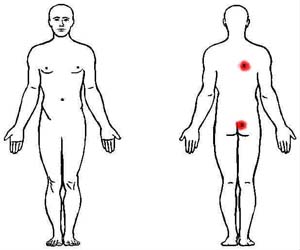
Multifidus Muscle Trigger Points
Multifidi Trigger Point

The origin of the multifidus muscle is the sacrum (multifidus spinae : pl. multifidi ), erector spinae aponeurosis, PSIS, and Iliac crest. The insertion of the multifidi is located in the spinous process. The muscle is innervated by posterior branches.
Trigger points of the multifidi are located in the upper back, shoulder, and arm. The primary symptoms are abdominal pain, back of neck pain, bloating, nausea, abdominal cramps, iliosacral pain, irritable bowel, low back pain, lumbar pain, mid-thoracic back pain, thoracic back pain, upper thoracic back pain, and the secondary symptoms are lower abdominal pain and sacral and gluteal pain. The diagrams show where pain is concentrated around the trigger points.
Conservative Treatments
Therapeutic treatments for addressing soft tissue injuries involve massage therapy, manual therapy, trigger point therapy, Graston Technique, or Active Release Technique. These treatments increase blood flow, decrease muscle spasms, enhance flexibility, speed healing, and promote proper tissue repair.
When these treatments are incorporated into a treatment plan patients heal faster and are less likely to have long-term pain or soft tissue fibrosis or scar tissue in the injured muscle. These soft tissue treatments are incorporated with therapeutic exercise and flexibility programs.
Chiropractic adjustments increase the movement of a joint complex. With injury, poor posture, sprains, and strains, muscles tighten up and the joints can become locked up. This lack of movement is felt when you can not look over your shoulder without feeling pulling, dull pain, or a twinge of pain. Mildly stuck joints can be loosened up in the day with stretching and range of motion exercises. Moderately stuck joints often need a little help to restore their normal motion with chiropractic adjustments. Severely stuck joints cause a person pain whenever they put pressure upon the joint or try and move the joint complex.
There are multiple ways to get a joint moving again. The most important part is that the joint is moving in its proper range of motion and without pain. Many people think chiropractors only perform manual manipulation. Most likely their first experience with a chiropractic was years ago, and manual manipulation was the most common form of treatment. Over time and with technology, treatments have changed with the same goal of getting neck joints moving. Learn more about Chiropractic adjustments.
Medical Treatments
NSAIDs are often prescribed for the initial acute injury stages. In severe cases that involve multiple joint regions, muscle relaxers or oral steroids can be given. Trigger point injections, botox, or steroid injections can be treatment options. Pain management is not usually required unless stronger medications or joint injections are required for treatment.
MRI and X-rays will not usually be ordered to evaluate mild to moderate muscle, tendon, and ligament injuries. Severe cases may utilize advanced imaging to rule out bone fractures, edema, nerve entrapments, disc herniations, disc bulges, tendon or muscle ruptures. NCV testing may be utilized in cases that also involve muscle, sensory, or reflex loss.
Sciatica is the term for radiating pain down the leg. Most commonly it comes from the back and radiates down the leg. Several back injuries and nerve entrapment injuries can cause sciatic pain in the leg. The pain patterns from a lumbar disc, lumbar joint sprain, sacroiliac sprain, or piriformis syndrome produces different patterns of radiating pain than trigger points. Proper identification of the pain pattern, along with reproduction of pain from palpation of the trigger point allows the provider and patient to feel comfortable with the diagnosis.
Likewise many trigger point injuries are associated with poor joint stabilization in the foot, knee, or hip. This leads to poor alignment and excessive forces being placed onto muscles and tendons. Pain on the outside of the knee or IT Band Syndrome is common in people with back pain because of how the pelvis tips with muscle back muscle spasms combined with weakness and poor stabilization of the hip and glute muscles. These people will also have multiple trigger points in the quadriceps, psoas, gastroc, soleus, and gluteus medius.
Your chiropractor, physical therapist, occupational therapist, or physician will evaluate your condition and make a proper diagnosis and treatment recommendations. Ask them any questions you might have about your injury.
Conclusion
The thoracic and lumbar spine works as a comprehensive unit performing many of the repetitive tasks at home, work, and recreational sports. Injuries to one area of the musculature often indicate that additional damage has been incurred by other muscles in the back. Combine this with possible dysfunction in the scapula, arms, and legs; and many muscles could be operating at less than optimal levels.
Many therapeutic exercises can help restore proper strength and endurance to the back and core muscles. Isometric and range of motion exercises are often the initial treatment exercises. Followed by single plane exercises for hip, knee, shoulder, neck, and back; flexion, extension, adduction, abduction, circumduction, inversion, and eversion. Dynamic exercises involving stability foam, rubber discs, exercise ball, and BOSU balls can be performed on the floor. The more unstable of the surface the more effort and stabilization is required of all the muscles.
Vibration plates enhance neuromuscular learning throughout the ankle, knee, foot, hip, and back muscles. Additional strength exercises can be found on the hip, knee, and foot strengthening pages. More information for injuries, treatments, and exercises for back pain.
Our Chandler, AZ Chiropractic & Physical Therapy clinic treats patients with a variety of muscle, tendon, joint, and ligament injuries. The clinic provides treatment for runners, tri-athletes, and weekend warriors in addition to common headache, neck, and back patients traditionally seen in Chiropractic, Physical Therapy, Massage Therapy clinics. We work with all ages and abilities of the residents in Phoenix, Tempe, Gilbert, Mesa, and Chandler AZ.